Environmental challenges in Europe and in the rest of the world are intertwined
Environmental challenges in Europe and in the rest of the world are intertwined
There is a two-way relationship between Europe and the rest of the world. Europe is contributing to environmental pressures and accelerating feedbacks in other parts of the world through its dependence on fossil fuels, mining products and other imports. Conversely, in a highly interdependent world, changes in other parts of the world are increasingly felt closer to home, both directly through the impacts of global environmental changes, or indirectly through intensified socio-economic pressures .
Climate change is an obvious example. Most of the growth in global greenhouse gas emissions is projected to occur outside Europe, as a result of increasing wealth in populous emerging economies. In spite of successful efforts to reduce emissions and a decreasing share in the global total, European societies continue to be major emitters of greenhouse gases (Chapter2).
Many of the countries that are most vulnerable to climate change are outside the European continent, others are our direct neighbours( 3 ). Often these countries are highly dependent on climate-sensitive sectors such as farming and fishing. Their adaptive capacity varies, but is often rather low, in particular due to persistent poverty The links between climate change, poverty and political and security risks and their relevance for Europe have been extensively analysed
Biodiversity has continued to decline globally despite a few encouraging achievements and increased policy action ( 9 ) ( 10 ). The global rate of species extinction is escalating and is now estimated to be up to 1000 times the natural rate ( 11 ). Evidence is growing that critical ecosystem services are under great pressure globally( 12 ). According to one estimate, approximately one quarter of the potential net primary production has been converted by humans, either through direct cropping (53%), land-use-induced productivity changes (40%) or human-induced fires (7%) ( A ) ( 13 ). While such figures should be treated with caution, they do give an indication of the substantial impact of humans on natur al ecosystems.
Loss of biodiversity in other regions of the world affects European interests in several ways. It is the world’s poor that bear the brunt of biodiversity loss, as they are usually most directly reliant on functioning ecosystem services ( 14 ). Increases in poverty and inequality are likely to further fuel conflict and instability in regions that are already characterised by often fragile governance structures. Moreover, reduced genetic variety in crops and cultivars implies future losses of economic and social benefits for Europe in such critical areas as food production and modern healthcare ( 15 ).
Global extraction of natural resources from ecosystems and mines grew more or less steadily over the past 25 years, from 40 billion tonnes in 1980 to 58 billion tonnes in 2005. Resource extraction is unevenly distributed across the world, with Asia accounting for the largest share in 2005 (48% of total tonnage, compared with Europe’s 13%). Over this period, a relative decoupling of global resource extraction and economic growth took place: resource extraction increased by roughly 50% and world economic output (GDP) by about 110% ( 16 ).
Nonetheless, resource use and extraction is still increasing in absolute terms, outweighing gains in resource efficiency. Such a composite indicator does not, however, reveal information on specific resource developments. Global food, energy and water systems appear to be more vulnerable and fragile than thought a few years ago, the factors responsible being increased demand, decreased supply, and supply instabilities. Over-exploitation, degradation and loss of soils are relevant concerns in this regard ( 17 ) ( 18 ) ( 19 ). With global competition and increased geographic and corporate concentration of supplies for some resources, Europe faces increasing supply risks ( 20 ).
Map 7.1 Global human appropriation of net primary production
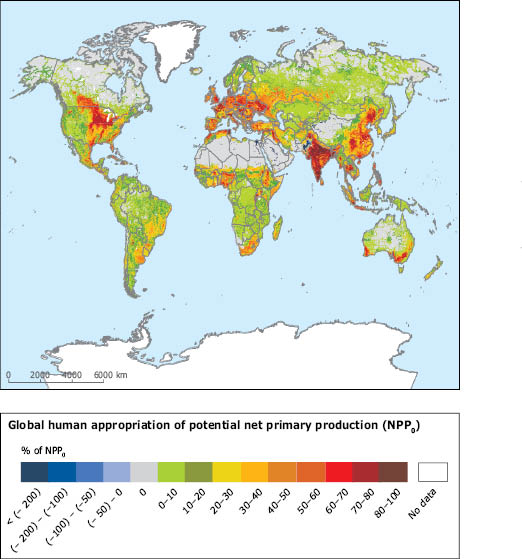
Note: This map shows human-appropriated net primary production (HANPP) as a percentage of potential net primary production (NPP) ( A ).
Source: Haberl et al. ( g ).
Figure 7.1 Global extraction of natural resources from ecosystems and mines, 1980 to 2005/2007

Source: SERI Global Material Flow Database, 2010 edition ( h ) ( i ).
In spite of general progress in the area of environment and health in Europe, the global human toll of environmental health impacts remains deeply worrying. Unsafe water, poor sanitation and hygiene conditions, urban outdoor air pollution, indoor smoke from solid fuels and lead exposure and global climate change account for nearly a tenth of deaths and disease burden globally, and around one quarter of deaths and disease burden in children under 5 years of age ( 21 ). It is again poor populations in low latitudes that are affected most heavily.
Table 7.1 Death and DALYs (disability-adjusted life years) ( B ) attributable to five environmental risks, by region, 2004
Risk | World | Low and middle income | High income |
|---|---|---|---|
Percentage of deaths | |||
Indoor smoke from solid fuels | 3.3 | 3.9 | 0.0 |
Unsafe water, sanitation, hygiene | 3.2 | 3.8 | 0.1 |
Urban outdoor air pollution | 2.0 | 1.9 | 2.5 |
Global climate change | 0.2 | 0.3 | 0.0 |
Lead exposure | 0.2 | 0.3 | 0.0 |
All five risks | 8.7 | 9.6 | 2.6 |
Percentage of DALYs | |||
Indoor smoke from solid fuels | 2.7 | 2.9 | 0.0 |
Unsafe water, sanitation, hygiene | 4.2 | 4.6 | 0.3 |
Urban outdoor air pollution | 0.6 | 0.6 | 0.8 |
Global climate change | 0.4 | 0.4 | 0.0 |
Lead exposure | 0.6 | 0.6 | 0.1 |
All five risks | 8.0 | 8.6 | 1.2 |
Source: World Health Organization ( j ).
Many low- and middle-income countries now face a growing burden from new risks to health, while still fighting an unfinished battle with the traditional risks to health. The World Health Organization (WHO) forecasts that between 2006 and 2015, deaths from non-communicable diseases could increase worldwide by 17%. The greatest increase is projected for the African region (24%) followed by the eastern Mediterranean region (23%) ( 22 ). Europe is likely to be faced with the increased problem of emerging or re-emerging infectious diseases that are critically influenced by changes in temperature or precipitation, habitat loss and ecological destruction ( 23 ) ( 24 ). In an increasingly urbanised world, which is tightly linked by long-distance transport, the incidence and distribution of infectious diseases affecting humans is likely to increase ( 25 ).
Box 7.1 Global sea-level rise and ocean acidification
During the 20th century, global sea level rose by an average of
1.7 mm/year. This was due to an increase in the volume of ocean water as a consequence of temperature rise, although inflow of water from melting glaciers and ice sheets is playing an increasing role. In the past 15 years, sea-level rise has been accelerating and averaged about 3.1 mm/year, based on data from satellites and tide gauges, with a significantly increasing contribution from the ice sheets of Greenland and Antarctica. Sea level is projected to rise considerably during this century and beyond.
In 2007, the IPCC presented a projected rise of 0.18 to 0.59 m above the 1990 level by the end of the century ( a ). However, since 2007, reports comparing the IPCC projections with observations show that sea level is currently increasing at an even greater rate than indicated by these projections ( b ) ( c ). Recent estimates suggest, in case of unabated greenhouse gas emissions, a projected global average sea-level rise of about 1.0 m or possibly (although unlikely) even up to 2.0 m, by 2100( d ).
Ocean acidification is a direct consequence of CO2 emissions to the atmosphere. The oceans have already taken up around a third of the CO2 produced by humankind since the industrial revolution. While this has limited the amount of CO2 in the atmosphere somewhat, it has come at the price of a significant change to ocean chemistry. Evidence indicates that ocean acidification is likely to become a serious threat to many organisms and will have implications for food webs and ecosystems, for example, tropical coral reefs.
It is expected that, at atmospheric carbon dioxide concentrations above 450 ppm, large areas of the polar oceans will probably become corrosive to shells of key marine calcifiers, an effect that will be strongest in the Arctic. Already, loss of shell weight in planktonic Antarctic calcifiers has been observed. The rate of change in ocean chemistry is high, and faster than previous ocean acidification-driven extinctions in the Earth’s history ( e )( f ).
Source: EEA.
Links between environmental challenges are particularly apparent in Europe's direct neighbourhood
Europe’s direct neighbourhood — the Arctic, the Mediterranean and the eastern neighbours — is worth particular attention here due to the strong socio-economic and environmental links and the importance of these regions in EU external policy. Furthermore, some of the world’s largest reservoirs of natural resources are in these regions, which is of immediate relevance to a resource-scarce Europe.
These regions are also home to some of the world’s richest and yet most fragile natural environments which are facing multiple threats. At the same time, concerns remain related to many transboundary issues like water management and air pollution deposition shared between Europe and its neighbours. Some of the main environmental challenges in these regions include:
• The Arctic — European activities, such as those resulting in long-range emission of air pollution, black carbon and greenhouse gas emissions, leave a considerable footprint in the Arctic. At the same time what happens in the Arctic also influences Europe’s environment because the Arctic plays a key role, for example, in the context of climate change and related sea-level rise projections. Furthermore, multiple pressures on Arctic ecosystems have resulted in biodiversity loss across the region. Such changes have global repercussions because of the loss of key ecosystem functions and are creating additional challenges for the people living in the Arctic as changing seasonal patterns affect hunting and food provision ( 26 ).
• Eastern neighbours — EU neighbours to the east face many environmental challenges affecting human health and ecosystems. The EEA’s fourth assessment report of Europe’s environment ( 27 ) summarises key environmental issues across the pan-European region, including countries in Eastern Europe, the Caucasus and Central Asia. It focuses on the challenges posed by air and water pollution, climate change, biodiversity loss, pressures on the marine and coastal environment, consumption and production patterns, and assesses sectoral developments that drive environmental change across the region.
• The Mediterranean — Located at the crossroad of three continents this is one of the richest ‘eco-regions’ and yet one of the most vulnerable natural environments in the world. The recent report on the State of the Environment and Development in the Mediterranean ( 28 ) presents the major impacts of climate change, the characteristics of the natural resources and environment in the region, and the challenges linked to their conservation. In particular, some of the main pressures from human activities are identified (such as tourism, transport, and industry) and their impacts on coastal and marine ecosystems are assessed, together with considerations about their environmental sustainability.
Box 7.2 The E uropean Neighbourhood Policy
The European Neighbourhood Policy (ENP) aims to strengthen cooperation between the EU and its neighbours. It is a dynamic and evolving platform for dialogue and action based on joint responsibility and ownership. In recent years, the ENP has been further strengthened through initiatives such as the Eastern Partnership, Black Sea Synergy and Union for the Mediterranean.
Within the ENP, relevant EU instruments — the EU maritime policy, the Water Framework Directive and the development of a Shared Environmental Information System (SEIS) — are gradually being implemented beyond EU borders to help streamline environmental efforts. International legal instruments have also been developed and gradually implemented to address common transboundary issues — such as the UN LRTAP Convention or transboundary water convention, covering also the eastern neighbours.
For the Mediterranean, the Horizon 2020 initiative ( k ) supports the riparian countries in addressing the priority issues of dealing with industrial emissions, municipal waste and wastewater treatment to reduce pollution of the Mediterranean.
Within the Arctic, a number of environmental treaties and conventions, as well as shipping and industrial regulations, provide a backdrop for policy deliberations in the context of the EU’s Arctic policy: while the EU has taken the first steps towards an Arctic Policy, no comprehensive policy approach exists at present, several EU policies — such as the EU’s agricultural policy, fisheries policy, maritime policy, environmental and climate policy or energy policy — affect the Arctic environment both directly and indirectly.
However, it is worth noting here that environmental trend analyses covering Europe’s neighbouring regions often lack reliable data and indicators that are comparable over time and space. Better and more targeted information to underpin environmental analysis and assessment is needed.
The EEA — within the framework of the European Neighbourhood Policy, and in cooperation with the countries and main partners in the regions — is implementing a series of activities that aim to strengthen existing environmental monitoring, data and information management.
Source: EEA.
While Europe is contributing directly and indirectly to some of the environmental pressures in these regions, it is also in an unique position to cooperate to improve their environmental conditions, particularly through fostering technology transfer and helping to build institutional capacity. These dimensions are increasingly reflected in European neighbourhood policy priorities ( 29 ).
Environmental challenges are closely connected with global drivers of change
A range of unfol ding trends are shaping the future European and global context, and many of these are outside the realm of Europe’s direct influence. Related global megatrends cut across social, technological, economic, political and even environment dimensions. Key developments include changing demographic patterns or accelerating rates of urbanisation, ever faster technological changes, deepening market integration, evolving economic power shifts or the changing climate.
Figure 7.2 A selection of global drivers of change relevant for the European environment
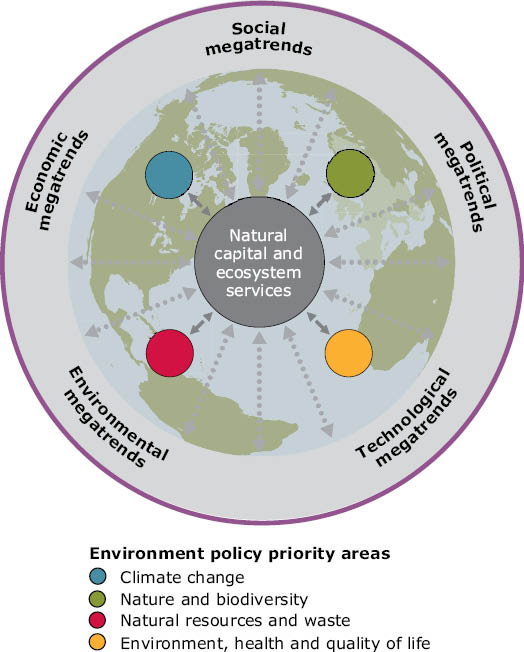
A selection of global megatrends
• Increasing global divergence in population trends: populations ageing, growing and migrating
• Living in an urban world: spreading cities and spiralling consumption
• Changing patterns of global disease burdens and the risk of new pandemics
• Accelerating technologies: racing into the unknown
• Continued economic growth
• Global power shifts: from a uni-polar to a multi-polar world
• Intensified global competition for resources
• Decreasing stocks of natural resources
• Increasing severity of the consequences of climate change
• Increasingly unsustainable environmental pollution load
• Global regulation and governance: increasing fragmentation, but converging outcomes
Source: EEA.
Table 7.2 Population of the world and different regions, 1950, 1975, 2005 and 2050 according to different growth variants
Region | Population in millions | Population in 2050 | |||||
1950 | 1975 | 2005 | Low | Medium | High | Constant | |
World | 2 529 | 4 061 | 6 512 | 7 959 | 9 150 | 10 461 | 11 030 |
More developed regions | 812 | 1 047 | 1 217 | 1 126 | 1 275 | 1 439 | 1 256 |
Less developed regions | 1 717 | 3 014 | 5 296 | 6 833 | 7 875 | 9 022 | 9 774 |
Africa | 227 | 419 | 921 | 1 748 | 1 998 | 2 267 | 2 999 |
Asia | 1 403 | 2 379 | 3 937 | 4 533 | 5 231 | 6 003 | 6 010 |
Europe * | 547 | 676 | 729 | 609 | 691 | 782 | 657 |
Latin America and Caribbean | 167 | 323 | 557 | 626 | 729 | 845 | 839 |
Northern America | 172 | 242 | 335 | 397 | 448 | 505 | 468 |
Oceania | 13 | 21 | 33 | 45 | 51 | 58 | 58 |
Europe (EEA-38) | 419 | 521 | 597 | 554 | 628 | 709 | 616 |
Note: * Europe (in UN terminology) includes all EEA member countries (except Turkey) and EEA cooperating countries, as well as Belarus, Republic of Moldova, Russian Federation, Ukraine.
Source: United Nations Population Division ( l .
In 1960, the world’s population was 3 billion. Today, it is about 6.8billion. The United Nations Population Division expects this growth to continue and that the global population will exceed 9billion by 2050, according to the ‘medium growth variant’ of their population estimate( 30 ). However, uncertainties are apparent, and forecasts depend on several assumptions, including for fertility rates. As such, by 2050, the world population could thus exceed 11 billion or be limited to 8 billion( 30 ). The implications of this uncertainty for global resource demands are huge.
In contrast to the global trend, European populations are expected to decline and age significantly. In its neighbourhood, population decline is particularly dramatic in Russia and large parts of Europe. At the same time, northern African countries along the southern Mediterranean are witnessing strong population growth. In general, the wider region of Northern Africa and the Middle East has experienced the highest rate of population growth of any region in the world over the past century ( 30 ).
The regional distribution of population growth, the age structure, and migration between regions are also important. Ninety percent of the population growth since 1960 has been in countries classified as ‘less developed’ by the United Nations ( 30 ). Meanwhile, the world is urbanising at an unprecedented rate. By 2050, about 70% of the global population is likely to live in cities, compared with less than 30% in 1950. Population growth is now largely an urban phenomenon concentrated in the developing world, particular Asia, which is estimated to be home to more than 50% of the global urban population by 2050 ( 31 ).
Global integration of markets, shifts in global competitiveness and changing global spending patterns comprise another complex set of drivers. As a result of liberalisation and due to the lowering of transport and communication costs, international trade over the past half-century has grown rapidly: global exports grew in value from USD296 billion in 1950 to more than USD8 trillion (measured in relation to ‘purchasing power parity’) in 2005, and their share of global GDP rose from around 5% to close to 20% ( 32 ) ( 33 ). Similarly, remittances sent home from emigrant workers often represent a large source of income for developing countries. For some countries remittances exceeded a quarter of the respective GDP in 2008 (forexample, 50% in Tajikistan, 31% in Moldova, 28% in the Krygyz Republic, and 25% in Lebanon) ( 34 ).
Aided by globalisation, many countries have been able to lift larger proportions of their populations out of poverty ( 35 ). Global economic growth and trade integration have fuelled long-term shifts in international competitiveness, characterised by a high growth of productivity in emerging economies. The number of middle-income consumers world-wide is growing rapidly, particularly in Asia ( 36 ). The World Bank has estimated that, by 2030, there could be 1.2billion middle-income consumers (C) in the emerging and developing economies of today ( 37 ). Already in 2010, the economies of the BRIC countries — Brazil, Russia, India and China — are expected to contribute almost half of global consumption growth ( 38 ).
Large differences in individual wealth accumulation are expected to persist between developed economies and key emerging economies. Yet the world’s economic balance of power is changing. Large shifts in purchasing power towards middle-income economies and middle-income consumers are underway, creating significant consumer markets in emerging markets that are likely to fuel future global resource demands, again particularly in Asia ( 39 ) ( 40 ). According to one estimate, the BRIC countries together could match the G7 share of global GDP by the 2040s ( 41 ).
Figure 7.3 Growth of GDP per capita in the EU-27, USA, China, Japan and India, 1980 to 2008
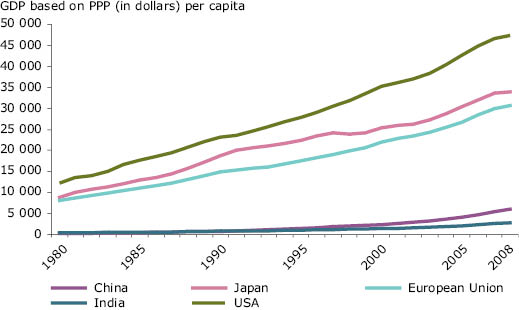
Source: International Monetary Fund ( m ).
Figure 7.4 Projected shares of global middle-income class consumption, 2000 to 2050
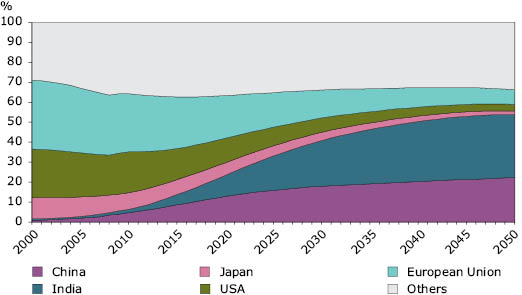
Source: Kharas ( n ).
A number of critical uncertainties are, however, embedded in those projections. Examples include uncertainties about the degree to which Asia might integrate economically, the impact of population ageing and the capacity to strengthen private investment and education. In the context of greater interconnectedness of markets and a higher susceptibility to risks of market failures, global regulatory regimes are likely to expand in the future, yet their contours and thus their role are unpredictable.
Furthermore, the speed and scope of scientific and technological progress influences key socio-economic trends and drivers. Eco-innovation and eco-friendly technologies are of key relevance in this regard; European companies are already relatively well-positioned in global markets. Supporting policies are relevant both in terms of facilitating market entry of new eco-innovations and technologies as well as increasing global demand (Chapter8).
In the longer-term perspective, developments and technology convergence in nanoscience and nanotechnologies, biotechnologies and life-sciences, information and communication technologies, cognitive sciences and neuro-technologies are expected to have profound effects on economies, societies and the environment. They are likely to open up completely new options for mitigating and remedying environmental problems including, for example, new pollution sensors, new types of batteries and other technologies for energy storage, and lighter and more durable materials for cars, buildings or aircrafts ( 42 ) ( 43 ) ( 44 ).
However, these technologies also give rise to concerns about detrimental effects on the environment, given the scale and level of complexity of their interactions. The existence of unknown, even unknowable, impacts poses a great challenge to risk governance( 45 )( 46 ). Rebound effects might also jeopardize environmental and resource-efficiency achievements ( 47 ).
As a result of demographic and economic power shifts, the contours of the global governance landscape are changing. A diffusion of political power towards multiple poles of influence is on-going, and changing the geo-political landscape ( 48 ) ( 49 ). Private actors such as multi-national enterprises are playing an increasing role in world politics, and are becoming more directly involved in the formulation and implementation of policies. Fostered by advances in communications and information technology, civil society is also increasingly taking part in global negotiation processes of all kind. The interdependence and complexity of decision-making is growing as a result, giving rise to new modes of governance and posing new questions about responsibility, legitimacy and accountability ( 50 ).
Environmental challenges may increase risks to food, energy and water security on a global scale
Global environmental challenges, such as impacts of climate change, loss of biodiversity, over-use of natural resourcesand environmental and health issues, are critically linked to issues of poverty and the sustainability of ecosystems, and consequently, issues of resource security and political stability. This adds pressure and uncertainty to the overall competition for natural resources, which might intensify as a consequence of increased demands, decreased supplies and decreased stability of supplies. Ultimately, this further increases pressure on ecosystems globally, and especially their capacity to ensure continued food, energy and water security.
According to the Food and Agriculture Organization of the United Nations (FAO), demand for food, feed and fibres could grow by 70% by 2050 ( 51 ). The fragility of global food, water and energy systems has become apparent over recent years. For example, arable land per person declined globally from 0.43 ha in 1962 to 0.26 ha in 1998. The FAO expects this value to fall further by 1.5% per year between now and 2030, if no major policy changes are initiated ( 52 ).
Similarly, the International Energy Agency (IEA) expects global demand for energy to rise by 40% over the next 20 years if no major policy changes are implemented ( 53 ). The IEA has repeatedly warned about an impeding global energy crisis due to rising long-term demand. Massive and continuous investments are needed in energy efficiency, renewable energies and new infrastructures to achieve the transition to a low-carbon, resource efficient energy system that is compliant with long-term environmental objectives ( 53 ) ( 54 ).
But it could be water shortages that will hit hardest over the coming decades. One estimate suggests that in just 20 years, global demand for water could be 40% higher than today, and more than 50% higher in the most rapidly developing countries ( 55 ). Furthermore, according to a recent estimate prepared by the Secretariat of the Convention of Biological Diversity, the flow in more than 60 per cent of the large river systems in the world has been heavily altered. Limits of ecological sustainability of water availability for abstraction have thus been reached, and up to 50% of the world could be living in areas with high water stress by 2030, while more than 60% could still lack improved access to sanitation ( 56 ).
Figure 7.5 Number of undernourished in the world; percentage of undernourished in developing countries, 1969 to 2009
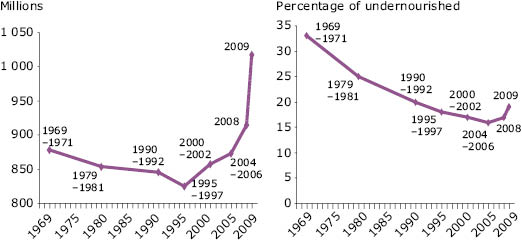
Source: Food and Agriculture Organization of the United Nations ( o ).
Water infrastructure systems are often old and there is a lack of information about actual performance and losses ( 57 ). One estimate foresees an average annual investment need of USD772 billion for maintaining water and wastewater services around the world by 2015 ( 58 ). Here, potential for ripple effects for food and energy supply exist, for example, cutting agricultural output which could result in decreasing overall social resilience.
Already today, in many parts of the world, non-renewable resource use is close to its limit and potentially renewable resources are being used beyond their reproductive capacity. This kind of dynamics can also be recognised in Europe’s neighbouring regions with their comparatively rich natural capital. Water resource over-exploitation, combined with insufficient access to safe drinking water and sanitation, for example, are critical challenges both in Eastern Europe and the Mediterranean ( 35 ).
At the global level, poverty and social exclusion are further exacerbated by ecosystem degradation and changes in the climate. Globally, efforts to alleviate extreme poverty were reasonably effective until the 1990s ( 51 ). However, the recurring food and economic crises throughout 2006 to 2009 have magnified the trend of increasing under-nourishment rates around the world. The number of undernourished rose, for the first time, to more than 1 billion in 2009 and the proportion of undernourished in developing countries, which was declining quite rapidly, has risen in the past few years.
Resource over-exploitation and changes in the climate aggravate threats to natural capital. They also affect quality of life, potentially undermining social and political stability ( 2 ) ( 8 ). Furthermore, the livelihoods of billions of people are inevitably linked with the sustainability of local ecosystem services. Combined with demographic pressures, decreasing socio-ecological resilience can add a new dimension to the environment and security debate, as conflict around scarcer resources is likely to intensify and add to migration pressures ( 2 ) ( 59 ).
Box 7.3 Towards identifying environmental thresholds and planetary boundaries
Earth system scientists are trying to understand the complexity of the interactions in bio-geophysical processes that determine the Earth’s capacity for self-regulation. In this regard ecologists have observed thresholds in a range of essential ecosystem processes, that when crossed cause the functioning of an ecosystem to fundamentally change.
More recently, a group of scientists have proposed a number of planetary boundaries within which humanity must stay to avoid catastrophic environmental change ( p ). They suggest that three critical boundaries have already been exceeded; the rate of biodiversity loss, climate change and human interference with the nitrogen cycle, but acknowledge that there are serious knowledge gaps and uncertainties.
The attempt to identify and quantify such planetary boundaries has started a broader debate about the feasibility of such an undertaking, and whether it is meaningful to calculate a global rate for processes some of which are inherently localised, for example nitrate levels and the loss of biodiversity ( q ). While the general value of such a scientific exercise can be acknowledged, concerns have been raised about the scientific justification, the possibility of choosing exact values that are non-arbitrary and the problems of reducing the complexity of interactions into single boundary values ( r ) ( s ).
Problems might arise with regard to balancing limits with ethical and economic issues and confusing values with targets. Some argue that the setting of quantitative boundaries might delay effective action and contribute to the degradation of the environment up to the point of no return ( t ) ( u ).
Source: EEA.
Global developments may increase Europe’s vulnerabilities to systemic risks
Since many of the global drivers of change operate beyond Europe’s direct influence, Europe’s vulnerability to external change could increase markedly, particularly accentuated by developments in its direct neighbourhood. Being a resource-scarce continent and neighbour to some of the world’s regions most prone to global environmental change, active engagement and cooperation with these regions can help address the range of problems that Europe is facing.
Many key drivers operate on a global scale and are likely to unfold over decades rather than years. In a recent assessment, the World Economic Forum warned about a higher level of systemic risk due to the increase in interconnections among various risks ( 60 ). Furthermore, the assessment emphasised that unexpected, sudden changes in external conditions are inevitable in a highly inter-linked world. While sudden changes can have huge impacts, the biggest risks may be from slow failures which unfold their full damage potential over decades and may be seriously underestimated in their potential economic impact and societal cost ( 60 ). The continued over-exploitation of natural capital is an example for a slow failure.
Such systemic risks — whether they manifest themselves as sudden changes or slow failures — include the potential damage to, or even full failure of, an entire system, for example a market or an ecosystem, as opposed to effects on individual elements only. The interconnectedness between drivers and risks highlighted here are relevant in this regard: while these links can lead to higher robustness when risk sharing is distributed across a greater number of elements in the system, they can also lead to greater fragility. Failure in one critical link can have cascading effects, often as a consequence of decreased system diversity and governance gaps ( 60 ) ( 61 ).
A key related risk is that of accelerating global environmental feedback mechanisms and their direct and indirect impacts on Europe. Since the Millennium Ecosystem Assessment (12) and the IPCCFourth Assessment Report ( 62 ), scientific assessments have warned that environmental feedback mechanisms are increasing the likelihood of large scale non-linear changes in key Earth system components. With increasing global temperatures, for example, there is an increasing risk of passing tipping points that may trigger large-scale, non-linear changes ( 63 ).
Systemic risks have the potential, if they are not properly addressed, to inflict devastating damage on the vital systems, natural capital and infrastructures on which our well-being depends both at a local and at a global scale. Thus, joint efforts are required to tackle some of the causes of systemic risks, develop adaptive management practices and strengthen resilience in view of increasingly pressing environmental challenges.
Box 7.4 Tipping points: risks of large scale (non-linear) climate change
What are tipping points? If a system has more than one equilibrium state, transitions to structurally different states are possible. If and when a tipping point is passed, the development of the system is no longer determined by the time-scale of the pressure, but rather its internal dynamics, which can be much more rapid than the original pressure.
A variety of tipping points have been identified, some of which have potentially significant consequences for Europe — however, it is worth noting that these may unfold on very different, and sometimes very long, time-scales.
One of the potential large-scale changes likely to affect Europe is the deglaciation of the West Antarctic ice sheet (WAIS) and Greenland ice sheet (GIS) — there is already evidence of accelerated melting of the GIS. Sustained 1–2°C, respectively 3–5°C, global warming above 1990 temperatures could be tipping points beyond which at least partial deglaciation of respectively GIS and WAIS and a significant rise in sea level will follow ( v ) ( w ).
There is less confidence about other non-linear effects, for example, what may happen with ocean circulation. Parts of the Atlantic meridianal overturning circulation exhibits considerable seasonal and decadal variability, but data do not support a coherent trend in the overturning circulation. A slow-down of the meridianal overturning circulation may temporarily counteract global warming trends in Europe, but may have unexpected and serious consequences elsewhere.
Other examples of possible tipping points are the accelerated emission of methane (CH4) from permafrost melting, destabilisation of hydrates on the ocean floor, and rapid climate-driven transitions from one ecosystem type to another. The understanding of these processes is as yet limited and the chance of major implications in the current century is generally considered to be low.
Source: EEA.
Map 7.2 Potential climatic tipping elements
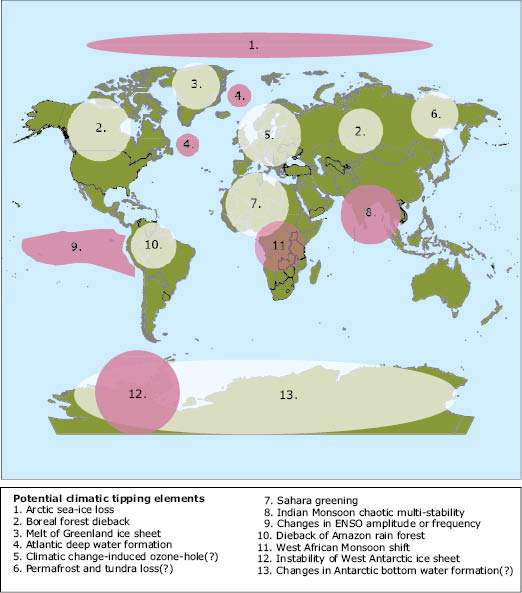
Note: Question marks (?) indicate systems whose status as tipping elements is particularly uncertain. There are other potential tipping elements not depicted here; for example, shallow-water coral reefs threatened in part by ocean acidification.
Source: Schellnhuber ( x ).
Figure 7.6 Estimated global warming at which the onset of the events could occur versus their impact
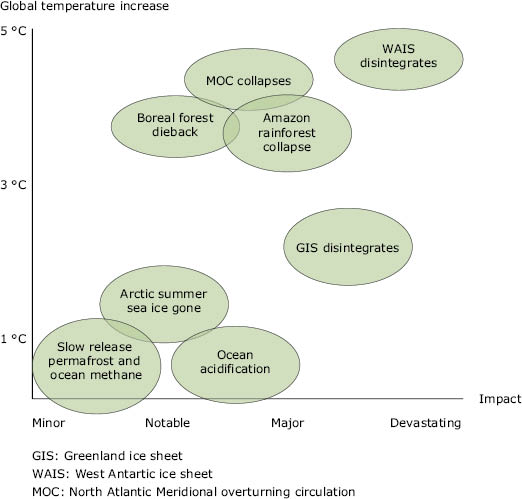



Comments